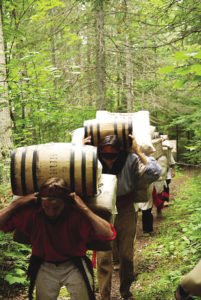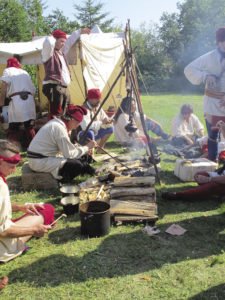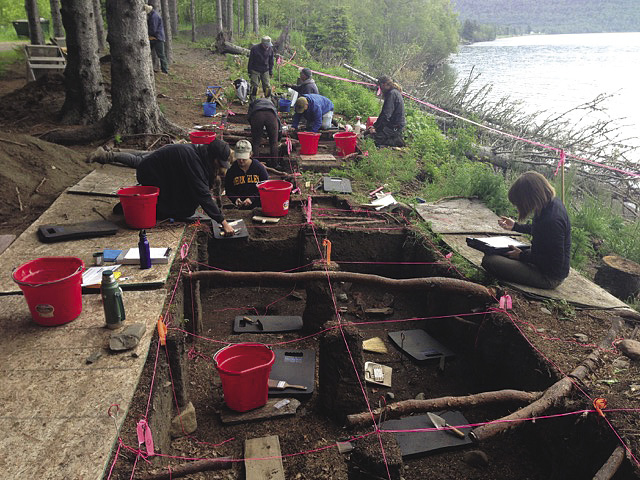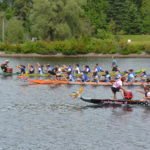The canoe is heavy and the bale is full of goods to sell. The trail is long, but paddling the river would be nearly impossible. The bugs are swarming and there are challenges around every bend. The terrain seems unforgiving, but there is no option other than to put one foot in front of the other on this path, the Grand Portage.
Visitors to the Grand Portage National Monument are transported through time to when the fur trade dominated the Northland. The infamously long and grueling portage connected the fur traders and the nearby residents, the Grand Portage Ojibwe. Today at the park, there are countless opportunities to connect with history through interpretive exhibits and re-enactments of daily life through cross-cultural experiences.
To understand the efforts of the fur traders and the uniqueness of their journey, it is helpful to consider the pathways through which they traveled. The park’s name comes from the footpath between the Pigeon River and Lake Superior. These native Ojibwe people have traveled this ‘portage,’ or path, for centuries to conduct trade with neighboring tribes and to access local hunting and gathering areas. The portage itself has its western terminus at the Pigeon River, which also forms part of the international border between the U.S. and Canada. Fort Charlotte, which was named after the wife of King George III, was a small depot used to store the trade items and furs before being delivered to either Grand Portage or interior trading posts of the North West Company. Voyageurs and Native peoples would also often carry their birch bark canoes, freshly caught Lake Superior fish, wild rice and raw copper from Isle Royale. Using the portage was a way to avoid the treacherous rapids, cascades and waterfalls of the Pigeon River.

Although explorers may have learned about the portage from Native peoples in the late 1600s, the first documented travel along the Grand Portage was made in 1731. Other explorers and traders soon learned about the pays d’en haut, or the “up country” of the northwest. When the British took control of the fur trade from the French in 1763, trade with the Ojibwe and other tribes expanded. The North West Company built its summer headquarters at the eastern edge of the Grand Portage and the route was used by guides, interpreters, voyageurs, clerks and others for the next 25 years.
“That time period of the fur trade was known on the world stage. If you were living in London or Paris you knew of the Grand Portage,” explained Pam Neil, chief of interpretation for the park.
Through her role, she is responsible for managing all the public access to the park, including the exhibits, programming and audiovisual presentations. She and her team is tasked with ensuring that each visitor has an amazing and interactive experience.
“Last year we had around 95,700 visitors to the park,” said Neil. “With budgets tight for all the national parks, we are very fortunate to have a team of seasonal rangers and volunteers that give visitors an opportunity to interact with no less than eight staff members during their visit on most days. We also have the ability to get visitors directly involved with a variety of interactive demonstrations and activities.”
The personal interaction extends to the exhibits in the four structures at the park: the Great Hall, the kitchen, the warehouse and the gatehouse. The Great Hall is historically furnished with period decoration from the 1790s and includes a try-it-on historic clothing exhibit. For those who are curious about the culinary choices of the era, the kitchen space is the place to see period cooking and baking demonstrations in the summer months. The Voyageur Encampment and Ojibwe Village includes demonstration of Ojibwe and voyageur life in the late 1700s.
“It’s fun to integrate people into their visit. They can get their hands in the dough and knead the bread if they want,” explained Neil. “When we have the lacrosse sticks out, you are welcome to just come and start playing. Join us in whatever we are doing.”
The second weekend in August is one of the largest festivals of the year for the Grand Portage Reservation and the National Monument. Representing the peak of the summer activity, the North West Company Rendezvous was when the furs from the wintering posts, which reached into Canada, were delivered down the Grand Portage. At the national monument, re-enactors from across the country and Canada gather to camp and challenge each other. The celebration is also held in conjunction with the Powwow, which is sponsored by the Grand Portage Band of Lake Superior Chippewa.
The Grand Portage National Monument has a special relationship with the native inhabitants of the land on which it sits.
“We are full partners with the tribe; that is really unique. That’s so important to what we do,” said Neil. “Our partnership is an example that other parks are hoping to follow. We are integrated into this community and it’s very special how we have grown together and worked together.”
There are always other research and restoration projects happening at the park. Steve Veit works in Cultural Resources as a museum technician. His role is to manage the museum collection, which includes checking the condition of the objects and processing the new finds.
Veit also works on the archeological excavations that take place within the monument boundaries and right now on the actual monument grounds themselves. The legal requirements on such a protected area ensure that any changes made to the physical environment are given intense consideration. The cultural resources staff also provides technical assistance to the Grand Portage Band and Cook County Historical Society in a variety of disciplines.

“Currently, we are conducting an archaeological survey in the depot area in preparation for the relocation of public restrooms. It will be almost like a public excavation around Rendezvous time. In order to do any serious ground disturbance as far as construction, we need to be able to evaluate the site first as part of a legal requirement,” said Veit. “We are looking at the ground there to make sure we aren’t impacting any significant archeological resources. That project will be taking us all through August and possibility into September.”
Natural resource restoration and research is also crucial to ensuring that the park can be enjoyed for many generations to come. Forest restoration, including putting white pine and tamarack back on the landscape, is a big undertaking for the biological team. Trade activities also affected the environment in ways that are still being discovered.
“The fur trade left an environmental legacy. There is quite a bit more mercury in the ground than there would have been otherwise,” resource assistant Brandon Seitz explained. “The mercury is there because of a trade object called vermillion. There was so much of it used, stored and applied at that time, that the mercury level is about 100 times what it would have been otherwise.”
Vermillion is a deep red pigment that was used as a face makeup by both women and men. Some of the voyageurs also applied it on tips of blades of paddles, and it might have been part of a fabric dye. The small sample they have is now used for scientific research and interpreted during visitor tours of the archives.
With help from the Great Lakes Restoration Initiative, the staff includes summer interns who have been working on exotic invasive species and traveling across the Arrowhead to do interpretation with the public.
Ranger-led interpretive programs and video presentations also help history come alive in the park. Those wishing to recreate and connect to the voyageurs and Native peoples can hike the entire 8.5-mile Grand Portage and camp at Fort Charlotte free of charge; a permit for camping is required, however. The steep half-mile Mt. Rose Nature Trail also offers scenic views of the depot and Lake Superior. This year’s Rendezvous Days expects to host 4,000-6,000 visitors and will be held on August 11-13. A schedule of events is available online at: nps.gov/grpo.




